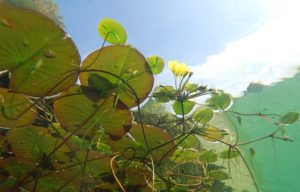A survey conducted in 2015 found that an average of one in ten homes across Britain have a garden pond or water feature. This statistic is encouraging although still doesn’t quite match the lose to wildlife of natural ponds and lakes. No matter what the goal is for a pond owner, whether for fish or to encourage wildlife, they all provide a habitat for amphibians, water insects, birds and small creatures. Ponds require less maintenance than that of a garden provided there is a good balance of aquatic plants, often referred to as natures best filtration system.

Garden ponds are defined as shallow bodies of water of up to 2 meters deep. The sun is able to penetrate such depths casting it’s rays to the bottom of the pond creating the perfect environment for submerged plants to grow. Floating plants such as the commonly know water lilly, grow on the surface and have no root system. They are beneficial in providing shade and shelter to pond inhabitants, but if not managed can grow across the surface blanking out the sun and preventing photosynthesis. Covering no more than 60% of the surface will prevent algae growth while providing sufficient shelter to pond creatures.
There are four types of aquatic plants, namely floaters, submerged, marginals and oxygenators. All offer benefits to maintaining a healthy pond ecosystem so it is good to add a few of each type – how many is dependent on pond size, depth and goal of pond. A healthy pond ecology is about balancing the life in your pond with the environment within – a shallow pond with little movement of water fully exposed to the sun and rich in nutrients is the perfect environment for algae growth. Not quite what a pond owner wants to see happen! This is important to note when setting your goals for a garden pond.
Aquatic plants offer numerous benefits to garden ponds. They are important to the life of fish and wildlife because they provide cover from danger, nesting areas and food. The presence of aquatic plants really depends on the goal for a pond with wildlife ponds likely to have a greater variety of plants versus a pond housing fish. Submerged plants are important to both types of ponds. They provide protection to small fish, release oxygen into the water and absorb and provide long-term storage of nutrients (that might otherwise be used to increase the levels of algae in a pond). Ponds with submerged plants have fewer problems with algae. However, grown in abundance and they could cause problems for fish pond owners.
The advantages to aquatic plants in garden ponds
- a decrease in water clarity can often be solved by adding submerged or oxygenating plants
- known as natures natural filtration system
- provide food and shelter to aquatic life
- aesthetically pleasing to a pond giving it character and dimension
Before rushing out to buy aquatic plants for your pond, here are three important things to note: some plants thrive in moving water while others prefer still waters, buy from a reputable aquatic trader who is more likely to sell disease free plants and buy native plants.
Can you feel the days getting longer – soon we will be outdoors soaking-up the sun while enjoying the tranquil beauty of our garden ponds!





